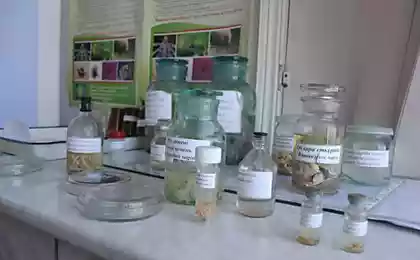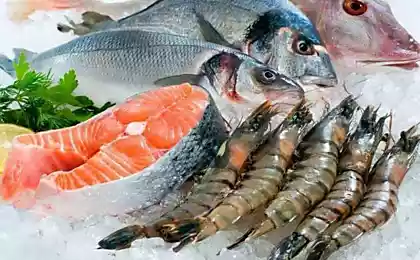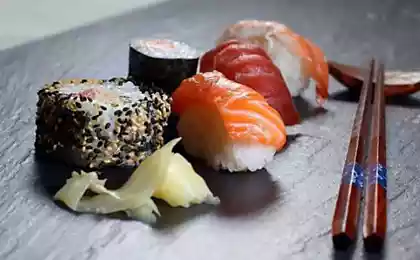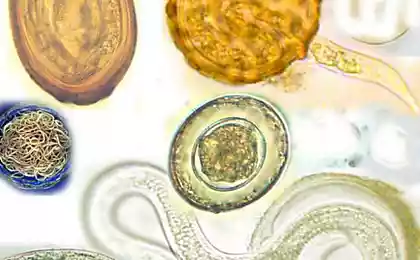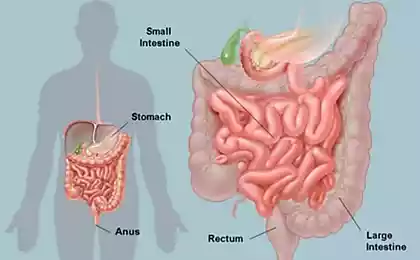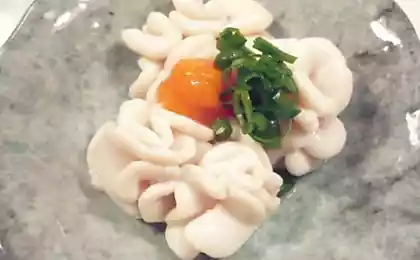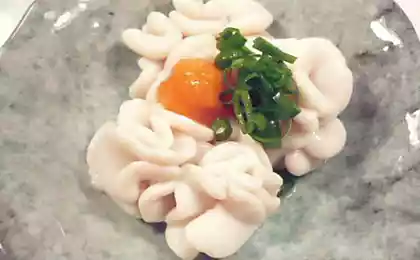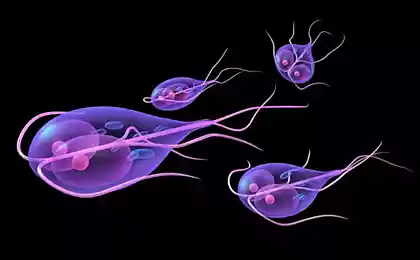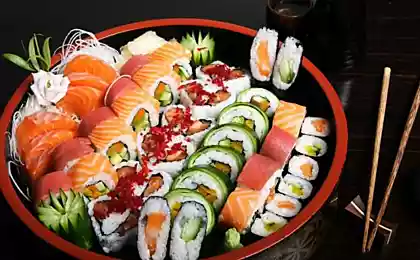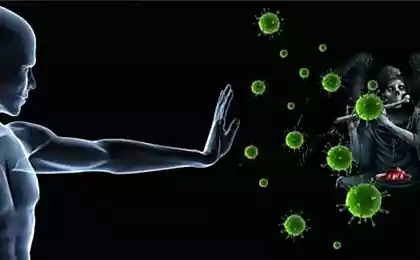609
Can I eat sushi. The answer is found and it will surprise you
Now many people are fond of exotic dishes, especially Japanese cuisine, every day more and more sushi restaurants. Fans of exotic Japanese cuisine and raw fish often do not think about what they risk.
"Sushi" or "sashimi" (Japanese say "sushi", "sashimi") — available, tasty and healthy. However, we must remember to follow some safety rules.
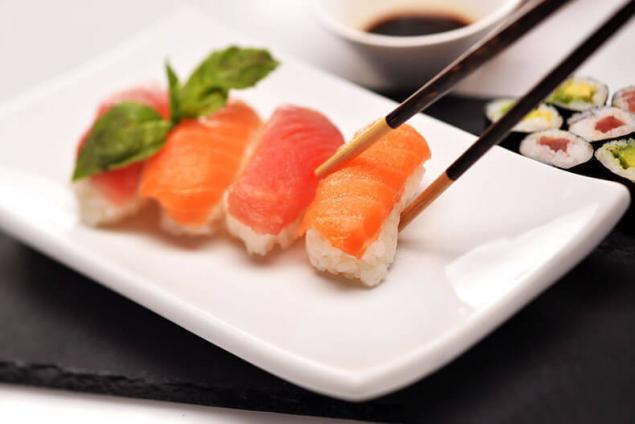
Raw fish is a classic source of helminths – parasitic worms that are dangerous to humans. According to the Institute of Parasitology, lovers of Asian food is at risk of becoming infected in the first place opisthorchiasis and difillobotrioz.
Adults opistorhisov parasites in the intestine, the bile ducts of the liver, gall bladder and pancreatic ducts. The average size of helminth — 7 - 12 mm. the Main symptoms of the disease — weakness, nausea, pain in the right hypochondrium, enlargement of the liver. The main foci of the disease are in the basins of the Ob, Irtysh, Volga, Kama river, the Desna, the Dnieper and its tributaries.
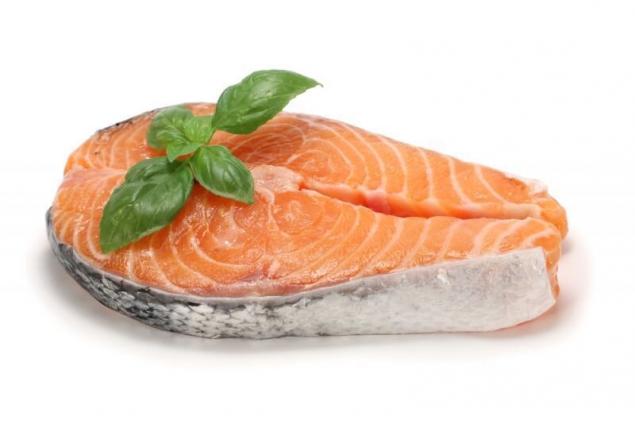
Difillobotrioz (a tapeworm) settle in the small intestine of man. The source of infection in this case perch, pike, burbot, but what is most unpleasant — far Eastern salmon and to a lesser extent whitefish (beloved all of us a red fish).
A tapeworm is a parasite in the human body for 10-20 years, while growing up to 15 meters and more. Signs of the presence of helminths of the gastrointestinal tract and periodical discharge of the body of the worms with the faeces. If a long time not to notice, you can earn vitamin B12 deficiency, and subsequent B12 deficiency anemia.
From the above examples it may seem that parasites infested only freshwater fish. In fact, helminths excellent feel and the inhabitants of the sea. The number of infections “marine” pests include antacids — disease, which causes the larvae of roundworms hookworms. Pathogens anisakidae human — larval stage of development of helminth genera.
The definitive hosts of these helminthes are many marine mammals (cetaceans, pinnipeds), predatory fish and piscivorous birds, in the gastrointestinal tract which are parasitic males and females of anisakid. The average length of 60-65 mm females males 50-55 mm. the Fertilized eggs fall into the water, where they comes out the larva, which swallow the first intermediate hosts are crustaceans from krill.
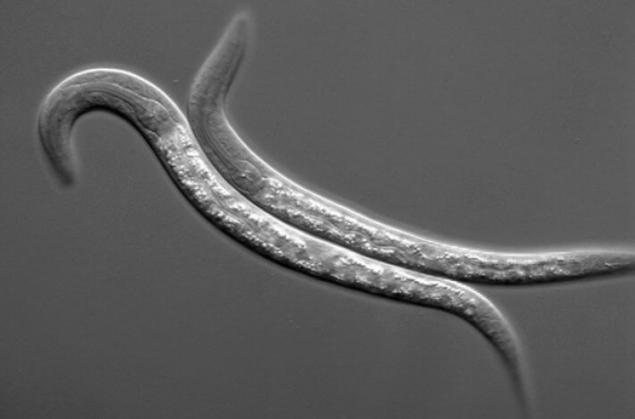
Infection of final hosts occurs when eating them infected intermediate hosts: fish, crustaceans and molluscs. If larger, the intermediate hosts eat the smaller ones, which invasionary larvae, then these larvae accumulate in the body larger, predatory fish.
These worms are striking in almost all types of sea fish — cod, mackerel, perches, salmon, and squid, octopus, shrimp and other crustaceans mollusks. And run up on your fish easier. According to statistics, the herring in the Baltic sea infected with nematodes by 30 %, and in North — generally for 55-100 %.
Round worms-parasites of anisakidae live in the intestines of fish. If the caught fish is frozen immediately, the worms remain in the intestines of the fish or die. If the fish for some time without freezing, the worms move from the intestine to muscle tissue.
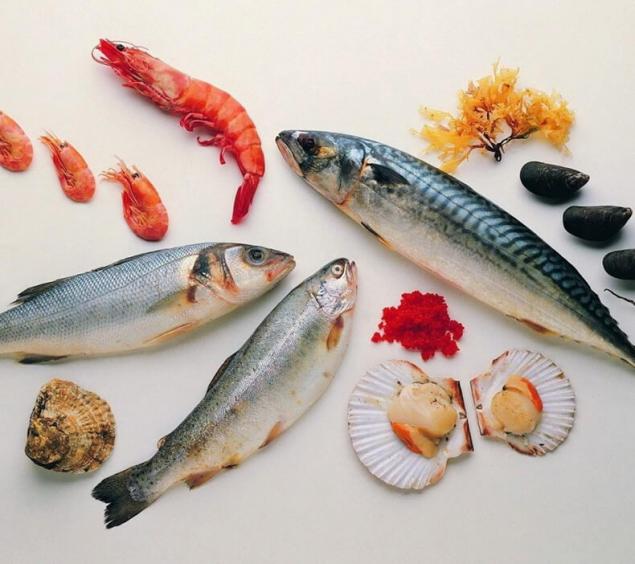
Eaten together with raw fish the parasite is usually embedded in the stomach wall, which is formed eosinophilic granules (swelling). As such, anisakid is saved and grows to 2-4, see introduction to nematodes can result in tragedy. Although this parasite usually lives in the human body, its larvae can cause sharp pain in the abdomen, to contribute to the development of acute ulceration with perforation and necrosis of the stomach wall and intestines. As a result, hospitalization of the person.
So can I eat sushi?
The complete disinfection of fish from all types of parasites (such as most resistant to low temperatures larvae of opisthorchid) is achieved (SanPiN 3.2.1333-03):
1. Freeze for 7 hours at minus 40°C or for 14 hours at minus 35°C or for 32 hours at minus 28°C. In freezers household refrigerators disinfection is not always the case, for example, the larvae of opistorchis can be kept viable for several months.
2. Salting the salt solution density of 1.2 g/l at 2-4°C for 14 days.
3. Cooking at least 20 minutes after boiling.
4. Hot with the lid closed for at least 20 minutes (10 minutes each side).
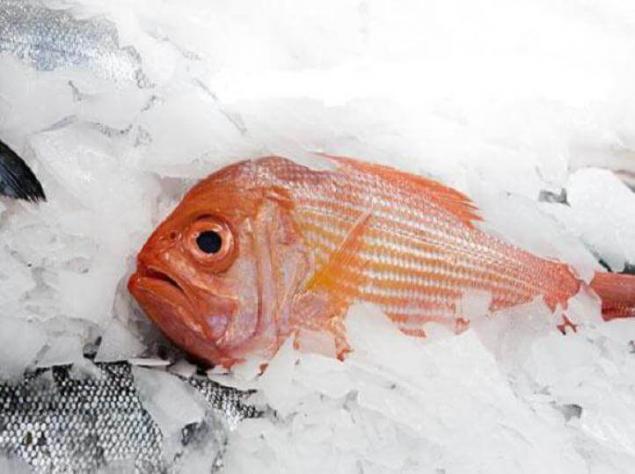
In Japan rules for pre-freezing of fish to use raw for sushi are strictly enforced! Although many people think that sushi in Japan is prepared from fresh (not frozen) fish.
However, sushi in the form as they are cooked in our restaurants, and the technology of their preparation came to us directly from Japan (and from Mexico), and perhaps something of the nuances of proper Japanese technology could be lost, or technology not observed strictly enough!
Check with the waiters in Japanese restaurants, some pre-processing was fish for sushi.
What not to do:
1. Be used raw for sushi or salted the fish, molluscs, crustaceans and other seafood that did not undergo pre-freezing for 7 hours at -40°C or for 32 hours at -28 °C. Similar rules exist for the preparation of for example, carpaccio of raw meat. Ideally, if freezing fish takes place immediately after the catch.
2. If the fish, shellfish and other seafood has not been frozen according to the rules of disinfection of parasites and larvae, such seafood should not be consumed in the salted form. Salting is allowed only within 10-40 days (depending on the size and type of fish) in the salt solution density of 1.2 g/l (preferably at 2 °C). Similar rules exist for preparing, for example, carpaccio of raw meat.
3. Use dried or dried fish that did not undergo pre-freezing or salting the rules to guarantee complete disinfection, because the larvae of opisthorchis in such fish are retained for months. This is especially true of breeds of carp fish (e.g., roach, roach, bream, carp, silver and gold carp, silver carp, tench, carp, IDE, sabrefish, ASP, sabrefish, roach, Rudd and many others), infestation with opisthorchiasis which is about 70%.
Drink this drink every morning and you will look 10 years younger!How and why you need to soak the beans
4. To eat insufficiently cooked or undercooked fish. Boil the fish should last for 20 minutes after boiling, the fish dumplings at least 5 minutes after boiling, crustaceans and mollusks for 15 minutes. To fry fish you need at least 20 minutes (10 minutes each side).
5. As the larvae of the parasite are directly in the muscles of fish, when it is cutting (in the case of using a knife, plates, cutting boards for other purposes) pollution cutting equipment and contamination of other foods.
Don't let a "stranger" living in Your body! published
Source: www.sethealth.ru/2016/10/18/%D0%BC%D0%BE%D0%B6%D0%BD%D0%BE-%D0%BB%D0%B8-%D0%B5%D1%81%D1%82%D1%8C-%D1%81%D1%83%D1%88%D0%B8-%D0%BE%D1%82%D0%B2%D0%B5%D1%82-%D0%BD%D0%B0%D0%B9%D0%B4%D0%B5%D0%BD/
"Sushi" or "sashimi" (Japanese say "sushi", "sashimi") — available, tasty and healthy. However, we must remember to follow some safety rules.

Raw fish is a classic source of helminths – parasitic worms that are dangerous to humans. According to the Institute of Parasitology, lovers of Asian food is at risk of becoming infected in the first place opisthorchiasis and difillobotrioz.
Adults opistorhisov parasites in the intestine, the bile ducts of the liver, gall bladder and pancreatic ducts. The average size of helminth — 7 - 12 mm. the Main symptoms of the disease — weakness, nausea, pain in the right hypochondrium, enlargement of the liver. The main foci of the disease are in the basins of the Ob, Irtysh, Volga, Kama river, the Desna, the Dnieper and its tributaries.

Difillobotrioz (a tapeworm) settle in the small intestine of man. The source of infection in this case perch, pike, burbot, but what is most unpleasant — far Eastern salmon and to a lesser extent whitefish (beloved all of us a red fish).
A tapeworm is a parasite in the human body for 10-20 years, while growing up to 15 meters and more. Signs of the presence of helminths of the gastrointestinal tract and periodical discharge of the body of the worms with the faeces. If a long time not to notice, you can earn vitamin B12 deficiency, and subsequent B12 deficiency anemia.
From the above examples it may seem that parasites infested only freshwater fish. In fact, helminths excellent feel and the inhabitants of the sea. The number of infections “marine” pests include antacids — disease, which causes the larvae of roundworms hookworms. Pathogens anisakidae human — larval stage of development of helminth genera.
The definitive hosts of these helminthes are many marine mammals (cetaceans, pinnipeds), predatory fish and piscivorous birds, in the gastrointestinal tract which are parasitic males and females of anisakid. The average length of 60-65 mm females males 50-55 mm. the Fertilized eggs fall into the water, where they comes out the larva, which swallow the first intermediate hosts are crustaceans from krill.

Infection of final hosts occurs when eating them infected intermediate hosts: fish, crustaceans and molluscs. If larger, the intermediate hosts eat the smaller ones, which invasionary larvae, then these larvae accumulate in the body larger, predatory fish.
These worms are striking in almost all types of sea fish — cod, mackerel, perches, salmon, and squid, octopus, shrimp and other crustaceans mollusks. And run up on your fish easier. According to statistics, the herring in the Baltic sea infected with nematodes by 30 %, and in North — generally for 55-100 %.
Round worms-parasites of anisakidae live in the intestines of fish. If the caught fish is frozen immediately, the worms remain in the intestines of the fish or die. If the fish for some time without freezing, the worms move from the intestine to muscle tissue.

Eaten together with raw fish the parasite is usually embedded in the stomach wall, which is formed eosinophilic granules (swelling). As such, anisakid is saved and grows to 2-4, see introduction to nematodes can result in tragedy. Although this parasite usually lives in the human body, its larvae can cause sharp pain in the abdomen, to contribute to the development of acute ulceration with perforation and necrosis of the stomach wall and intestines. As a result, hospitalization of the person.
So can I eat sushi?
The complete disinfection of fish from all types of parasites (such as most resistant to low temperatures larvae of opisthorchid) is achieved (SanPiN 3.2.1333-03):
1. Freeze for 7 hours at minus 40°C or for 14 hours at minus 35°C or for 32 hours at minus 28°C. In freezers household refrigerators disinfection is not always the case, for example, the larvae of opistorchis can be kept viable for several months.
2. Salting the salt solution density of 1.2 g/l at 2-4°C for 14 days.
3. Cooking at least 20 minutes after boiling.
4. Hot with the lid closed for at least 20 minutes (10 minutes each side).

In Japan rules for pre-freezing of fish to use raw for sushi are strictly enforced! Although many people think that sushi in Japan is prepared from fresh (not frozen) fish.
However, sushi in the form as they are cooked in our restaurants, and the technology of their preparation came to us directly from Japan (and from Mexico), and perhaps something of the nuances of proper Japanese technology could be lost, or technology not observed strictly enough!
Check with the waiters in Japanese restaurants, some pre-processing was fish for sushi.
What not to do:
1. Be used raw for sushi or salted the fish, molluscs, crustaceans and other seafood that did not undergo pre-freezing for 7 hours at -40°C or for 32 hours at -28 °C. Similar rules exist for the preparation of for example, carpaccio of raw meat. Ideally, if freezing fish takes place immediately after the catch.
2. If the fish, shellfish and other seafood has not been frozen according to the rules of disinfection of parasites and larvae, such seafood should not be consumed in the salted form. Salting is allowed only within 10-40 days (depending on the size and type of fish) in the salt solution density of 1.2 g/l (preferably at 2 °C). Similar rules exist for preparing, for example, carpaccio of raw meat.
3. Use dried or dried fish that did not undergo pre-freezing or salting the rules to guarantee complete disinfection, because the larvae of opisthorchis in such fish are retained for months. This is especially true of breeds of carp fish (e.g., roach, roach, bream, carp, silver and gold carp, silver carp, tench, carp, IDE, sabrefish, ASP, sabrefish, roach, Rudd and many others), infestation with opisthorchiasis which is about 70%.
Drink this drink every morning and you will look 10 years younger!How and why you need to soak the beans
4. To eat insufficiently cooked or undercooked fish. Boil the fish should last for 20 minutes after boiling, the fish dumplings at least 5 minutes after boiling, crustaceans and mollusks for 15 minutes. To fry fish you need at least 20 minutes (10 minutes each side).
5. As the larvae of the parasite are directly in the muscles of fish, when it is cutting (in the case of using a knife, plates, cutting boards for other purposes) pollution cutting equipment and contamination of other foods.
Don't let a "stranger" living in Your body! published
Source: www.sethealth.ru/2016/10/18/%D0%BC%D0%BE%D0%B6%D0%BD%D0%BE-%D0%BB%D0%B8-%D0%B5%D1%81%D1%82%D1%8C-%D1%81%D1%83%D1%88%D0%B8-%D0%BE%D1%82%D0%B2%D0%B5%D1%82-%D0%BD%D0%B0%D0%B9%D0%B4%D0%B5%D0%BD/



